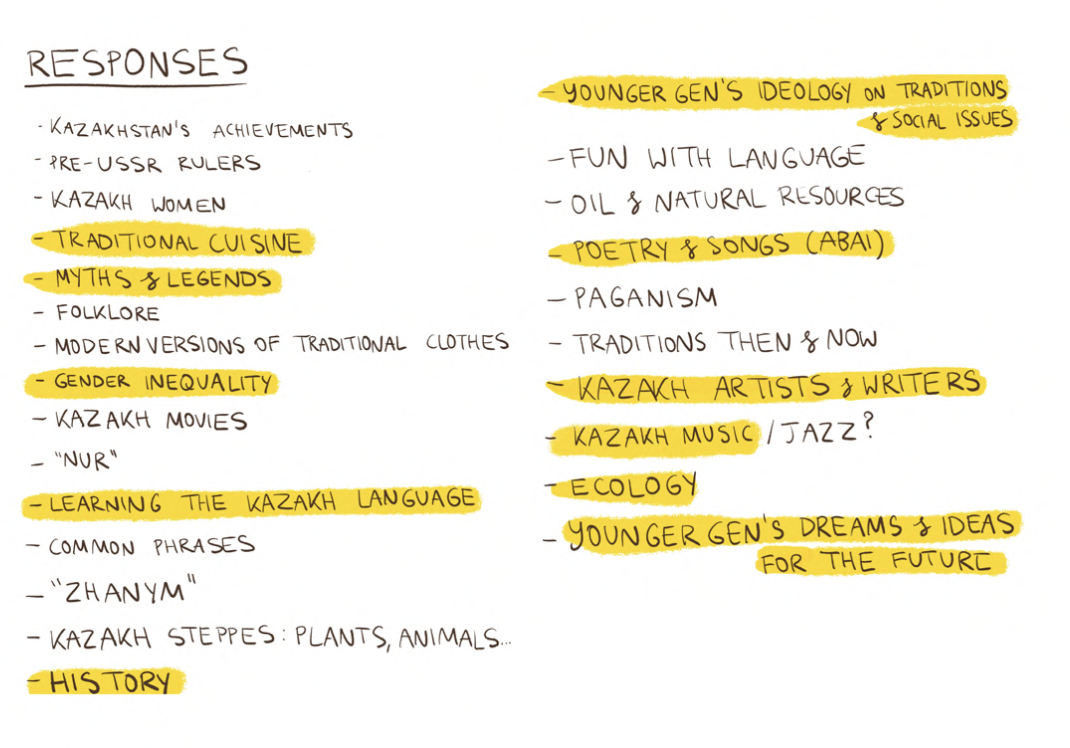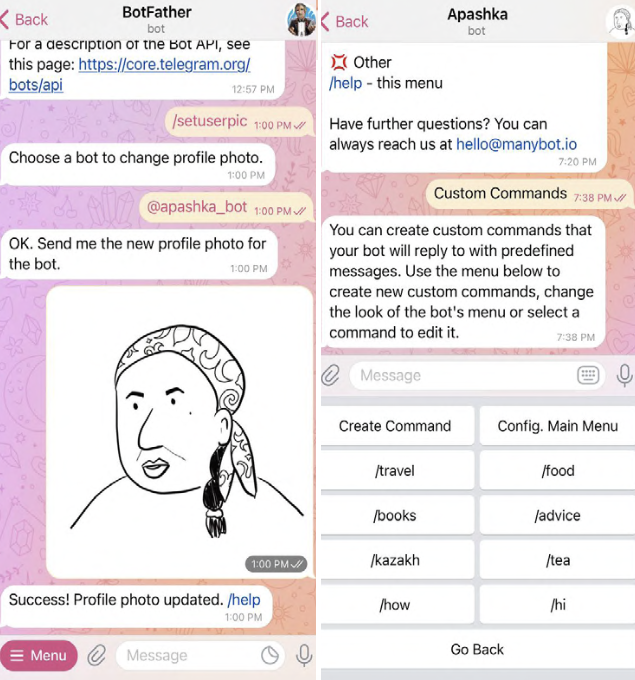Behind The Scenes:
Tea with Apashka
Project:
“Tea with Apashka” — an interactive experience that introduces its users to Kazakh culture.
Problem:
How can English-speaking audiences learn about Kazakh culture in an authentic, yet playful way?
Solution:
A web-experience where an old Kazakh woman invites the user for tea, and with each tea cup, introduces the user to various aspects of Kazakh culture.
Lessons learnt:
Creating a character can be a great way to make a complex topic fun and engaging; however, the process of creating this character and their story will certainly require a lot of work in order to achieve an authentic representation. Another lesson — gamification is amazing!
Tools & Processes:
Ideation / Research / User Interviews / Procreate / Telegram / Figma / Construct 3
1. Brainstorming
Setting the learning outcomes for this project
For my final university project, I had the freedom to work on anything, as long as I would effectively develop it from start to finish — so I’ve decided to use this opportunity to work on something that could help me explore both my identity and my practice. As a result, there were two starting factors — me being Kazakh and feeling isolated from my culture, and me exploring graphic communication design. Now, who could be the wider audience that would benefit from this brief?
Finding & getting to know the audience
Other Kazakhs who grew up outside of Kazakhstan, as well as curious foreigners, would also benefit from a project that could talk about Kazakh culture in a new & exciting way. This led me to the idea of creating an engaging platform for people to learn about Kazakh culture — my next step was to get to know my audience. I was able to find my target audience through a Facebook group, and I then conducted a series of interviews to get to know what people were interested in learning about.
For my final university project, I had the freedom to work on anything, as long as I would effectively develop it from start to finish — so I’ve decided to use this opportunity to work on something that could help me explore both my identity and my practice. As a result, there were two starting factors — me being Kazakh and feeling isolated from my culture, and me exploring graphic communication design. Now, who could be the wider audience that would benefit from this brief?
Finding & getting to know the audience
Other Kazakhs who grew up outside of Kazakhstan, as well as curious foreigners, would also benefit from a project that could talk about Kazakh culture in a new & exciting way. This led me to the idea of creating an engaging platform for people to learn about Kazakh culture — my next step was to get to know my audience. I was able to find my target audience through a Facebook group, and I then conducted a series of interviews to get to know what people were interested in learning about.


2. Defining
Initial ideas — which were nice, but lacked personality
After analysing the responses, I began creating some simple sketches and prototypes of how the platform would work. Feedback from peers and some experienced designers helped me realize that my ideas were interesting, but not engaging or personal enough. How could I make them better?




Refined idea — shaping a personality through creating a character
One of my main creative partners in life is my grandma, and talking to her made me realize that there is no better way to get to know Kazakh culture than speaking to a Kazakh grandma! The “sassy grandma” character is in fact present in many cultures, which made the idea of developing a Kazakh grandma-storyteller even more appealing to me; this character would be universal, yet still personal and unique.


3. Designing
Illustration and writing — creating Apashka’s personality
Developing Apashka’s character (“Apashka” is the Kazakh word for referring to a grandma/older woman) was a mixture of lived experience, research, doodling and mind maps. Visually speaking, I was particularly inspired by French illustration.
![]()
![]()
Prototyping on Figma and creating the experience & the Apashka ChatBot
After finishing the illustrations & a rough character storyline, I started putting those together into a fuller digital experience. I experimented with an interactive Figma prototype, which acted like a simple narration game, and a Telegram bot, where I’ve taught Apashka how to respond to a number of prompts.
![]()
![]()
![]()
Developing Apashka’s character (“Apashka” is the Kazakh word for referring to a grandma/older woman) was a mixture of lived experience, research, doodling and mind maps. Visually speaking, I was particularly inspired by French illustration.


Prototyping on Figma and creating the experience & the Apashka ChatBot
After finishing the illustrations & a rough character storyline, I started putting those together into a fuller digital experience. I experimented with an interactive Figma prototype, which acted like a simple narration game, and a Telegram bot, where I’ve taught Apashka how to respond to a number of prompts.



4. Testing
The experience was fun, but unclear
After testing my prototypes on a number of peers, I came to a conclusion that “Tea with Apashka” needed more depth and context, as well as a more immersive experience. A Figma prototype wasn’t enough — so I took a step back, and worked more on developing the storyline, as well as looking for other platforms where I could develop the game.
![]()
Going back to the drawing board — and improving the user journey
I’ve divided the user journey into 6 main stages, and worked further on a clear, immersive introduction, a Tearoom-homepage, and a clear ending. My next step was figuring out the technical aspect of the idea.
![]()
![]()
Learning Construct 3, and creating a full-on game: sounds, levels as cups, storytelling.
I’ve moved on from Figma to Construct 3, as it allowed me to add sounds to the experience — which made it a lot more immersive, and develop it more like a game, rather than a webpage. My grandma was kind enough to voice the experience, and adding her voiceover was a complete game-changer! Construct 3 is a platform for event-based programming, and after I’ve learnt how to use it, I was able to create a simple and fun game, where the user gets invited to have tea with Apashka, and with each tea cup, learn more and more about Kazakh culture.
After testing my prototypes on a number of peers, I came to a conclusion that “Tea with Apashka” needed more depth and context, as well as a more immersive experience. A Figma prototype wasn’t enough — so I took a step back, and worked more on developing the storyline, as well as looking for other platforms where I could develop the game.

Going back to the drawing board — and improving the user journey
I’ve divided the user journey into 6 main stages, and worked further on a clear, immersive introduction, a Tearoom-homepage, and a clear ending. My next step was figuring out the technical aspect of the idea.


Learning Construct 3, and creating a full-on game: sounds, levels as cups, storytelling.
I’ve moved on from Figma to Construct 3, as it allowed me to add sounds to the experience — which made it a lot more immersive, and develop it more like a game, rather than a webpage. My grandma was kind enough to voice the experience, and adding her voiceover was a complete game-changer! Construct 3 is a platform for event-based programming, and after I’ve learnt how to use it, I was able to create a simple and fun game, where the user gets invited to have tea with Apashka, and with each tea cup, learn more and more about Kazakh culture.


Taking notes about my process for future reference:
Since some of my technical ideas didn’t have specific tutorials about them —such as turning a full cup of tea into an empty one after talking to Apashka, I had to be very vigilant about documenting my solutions. I can’t begin to describe the pure joy I’ve felt when I finally came up with the cups solution!


5. Launching
Putting everything together and posting on Itch
After another round of testing and checking everything, “Tea with Apashka” was finally ready to be launched & submitted as my final project — you can click here to check it out yourself. Wohoo!
![]()
Some screenshots from “Tea with Apashka”:
![]()
![]()
After another round of testing and checking everything, “Tea with Apashka” was finally ready to be launched & submitted as my final project — you can click here to check it out yourself. Wohoo!

Some screenshots from “Tea with Apashka”:


Apashka’s future
As this project is a creative experiment, rather than a finished product, it still has potential to grow, develop and make real difference. The long term goal for this experiement is to figure out how learning about culture can be a fun and enjoyable experience — just like sharing gossip over a cup of tea.
You have now reached the end of this process log. Thank you for your time! :)
